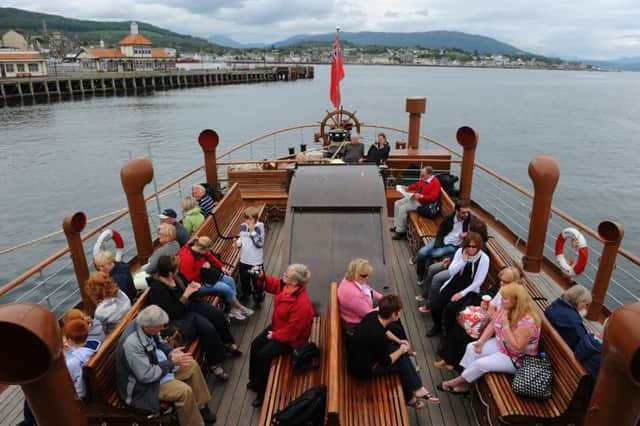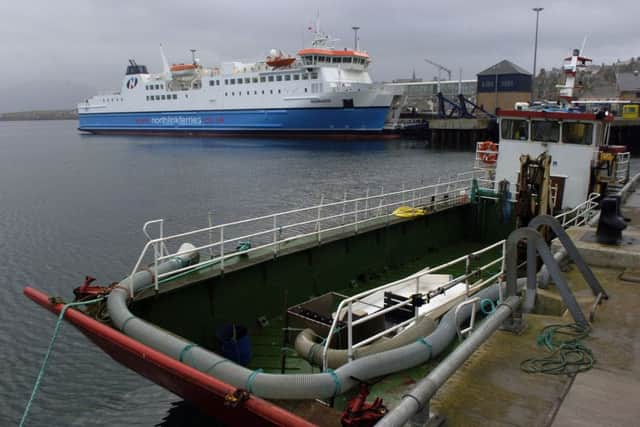Could white space technology fill Scotland’s broadband blackhole?


But, as anyone who has tried to check their Twitter feed or upload a Facebook picture while in one of these special places knows, that very remoteness can prove problematic in the digital age.
While a lack of internet connection - or merely a slow one - can be mildly irritating or inconvenient to the passing tourist, for businesses in the 21st century, it can be devastating.
Advertisement
Hide AdAdvertisement
Hide AdOf course, nobody wants to see new mobile phone masts sprouting up everywhere, so slow or no internet has been accepted as part and parcel of many of Scotland’s remote places.


That attitude is changing, however, thanks to a quiet revolution taking place in the airwaves.
Earlier this year, the UK’s communication regulator Ofcom committed to enabling the commercial use of the new TV White Space technology by early 2016 . This means that communities will be able to construct their own local networks, filling gaps left by commercial network operators.
Why do rural communities and businesses have to suffer poor connectivity?
The dominant media for broadband access have been telephone and cable TV systems – using existing wiring to customers’ premises. This has enabled cost-effective broadband delivery to millions of homes and businesses across the UK. However, cable TV systems are not usually found in rural areas and the telephone line technology (DSL) struggles to serve properties more than a few km from the telephone exchange. The answer to delivering increased performance has been to bring optical fibre closer to where the end users live. It would be very expensive to bring fibre to every home or business, so fibre is usually brought to a hub in the neighbourhood, from which other technologies can be used to make the final hop. BT use this technique to implement ‘Superfast’ broadband services (30 Mbps +) – but again the number of homes/premises that can be served depends on the length of the telephone wire from the hub (street cabinet).


Wireless technology can also be used from optical fibre hubs, to help broadband access reach further and more flexibly into rural communities. An increasingly large number of people use wireless technology (mobile broadband) to stay connected using mobile device as we move around. The snag with these licensed (cellular) wireless technologies (3G, 4G etc.) is that they can only be deployed by (typically) large operators – who normally find rural provision commercially unattractive. Now, however there is a new technology (referred to as TV white spaces) which is more cost-effective for wide area broadband access distribution and may be used on a licence-exempt basis – in other words property owners and communities can now ‘roll’ their own networks.
This already happens inside homes and offices, where users install Wi-Fi routers and can enjoy them licence-free. Now with TV white spaces, we can start to tackle unconnected communities.
What is TV White Space technology?
TV White Space is a new way of implementing wireless connectivity, which promises to deliver broadband to the parts other systems can’t reach, relying on gaps between television broadcast frequencies - many of which were freed up by the switchover from analogue to digital TV between 2008 and 2012.
Advertisement
Hide AdAdvertisement
Hide AdRadio signals at these frequencies - between 470MHz and 790MHz - can travel long distances, skirt around hills and through buildings and trees, making them ideal for delivering broadband internet to many areas of rural Scotland. Speeds can vary depending on the terrain, range and number of users.
Several successful pilot schemes have already taken place across UK, including in Orkney, Bute, Glentress and even the Waverley Paddle Steamer, with technology giants suh as Google, Microsoft and SKY getting behind the trials.
In addition to offering internet access to rural areas, White Space technology could be used to provide connectivity across university campuses, hospitals and throughout cities.
The Centre for White Space Communications, based at the University of Strathclyde, is a multi-disciplinary industry and academic centre investigating and undertaking research and development in the field of White Space. Its work to establish the viability of TV white space in rural connectivity has been supported by Scottish Government funding, propelling it to international pre-eminence in the field. Microsoft has been drawing on its expertise to help deliver affordable broadband to remote rural communities across Africa.
What effect can better broadband have?
Aside from the benefits of convenience for tourists and locals, faster broadband speeds in Scotland’s rural areas could have a profound positive effect on local businesses.
A 2013 report commissioned by the Government’s Department for Culture, Media & Sport estimated that faster broadband speeds will “add about £17 billion to the UK’s annual Gross Value
Added by 2024 “.
According to the UK Broadband Impact Study: “The bulk of this economic impact comes from improvements in the productivity of broadband-using firms, but there are also significant benefits from safeguarding employment in areas which would otherwise be at an unfair disadvantage, from productivity-enhancing time-savings for teleworkers, and from increased participation in the labour force. The total net employment impacts from faster broadband rise to about 56,000 jobs at the UK level by 2024, and about 20,000 jobs are attributable to the publicly funded intervention.”
In addition to the economic benefits of faster broadband, the Government study also predicts environmental advantages: “We estimate that, by 2024, it will save a total of 2.3 billion kms in
Advertisement
Hide AdAdvertisement
Hide Adannual commuting, predominantly in car usage, through enabling increased telework for a proportion of the workforce… and 5.3 billion kms in annual business travel, predominantly in car usage, through the increased use of video and online collaboration tools by broadband-using firms. This is in the order of 9% of the current total annual UK business travel distance.”
As well as enabling small businesses in Scotland to improve their own operations and make efficiency savings that allow them to achieve parity with their competitors in more technologically connected and less geographically remote areas, the adoption of White Space technology will open up significant opportunities for further cost saving and commercial development by enabling a move to cloud-based computing services.
Until relatively recently, access to hyper-scale cloud-based services has been the reserve of larger commercial organisations, but now the availability of affordable, scalable and secure enterprise-grade cloud services, combined with revolutionary communications technologies including White Space, has dramatically levelled the playing field and has the potential to empower even the smallest of Scottish businesses to compete and flourish in an increasingly cloud-first world.
Looking beyond the established local businesses that will feel the positive effects of White Space technology, increasing the technological maturity of the more remote areas of Scotland will make those areas more attractive to other companies looking to expand and invest, benefitting the local economy as a whole and in turn help elevate the overall ability of Scotland as a country to compete on a global stage.
According to the UK Broadband Impact Study: “The bulk of this economic impact comes from improvements in the productivity of broadband-using firms, but there are also significant benefits from safeguarding employment in areas which would otherwise be at an unfair disadvantage, from productivity-enhancing time-savings for teleworkers, and from increased participation in the labour force. The total net employment impacts from faster broadband rise to about 56,000 jobs at the UK level by 2024, and about 20,000 jobs are attributable to the publicly funded intervention.”
In addition to the economic benefits of faster broadband, the Government study also predicts environmental advantages: “We estimate that, by 2024, it will save a total of 2.3 billion kms in annual commuting, predominantly in car usage, through enabling increased telework for a proportion of the workforce… and 5.3 billion kms in annual business travel, predominantly in car usage, through the increased use of video and online collaboration tools by broadband-using firms. This is in the order of 9% of the current total annual UK business travel distance.”
Why don’t we all have White Space technology now?
With all these benefits seemingly within reach, what has been holding White Space back?
One big challenge has been the need to satisfy regulators that the technology will not impair TV reception. Another has been that TV channels’ use of frequencies vary by region and can change over time, meaning that White Space systems need to remain agile. This is achieved through the use of central databases which keep updated lists of all the available frequencies which are safe to use.
Advertisement
Hide AdAdvertisement
Hide AdAnd while White Space frequencies can pass through walls and buildings with ease, saving on the need for expensive Wi-Fi boosters or repeaters, the hardware itself is currently expensive.
However, trials such as those in Orkney, Glentress and on the PS Waverley are all part of the process of ironing out the wrinkles of White Space and moving closer to a day when even the remotest parts of rural Scotland can benefit from usable broadband.
Case Studies
Tweedlove Bike Festival in Glentress Forest
As one of the most hotly anticipated events on Scotland’s mountain-biking calendar, the Enduro event at the Tweedlove Bike Festival in Glentress Forest attracts around 600 riders from around the world and thousands of spectators, all keen for the best view of the action. Unfortunately, in a forested, hilly and remote area, that can be easier said than done.
However, at this May’s event, Scottish Enterprise, the Mountain Bike Centre of Scotland and Microsoft teamed up to stream live coverage via White Space onto a big screen for onsite spectators.
“Our work to date has proved that use of this technology will allow people to do more and achieve more,” said Jim Beveridge, senior director of International Technology Policy at Microsoft. “As well as enhancing the TweedLove EWS spectator experience on-site by providing coverage and internet access, the Glentress forest TVWS trial shows first time communication connection opportunities for businesses, conservation projects and outdoor tourist pursuits in some of the most remote, forested and mountainous areas of the UK. Now we look forward to turning these trials into commercial realities to benefit people across the world.”
Orkney
In 2014, Orkney-based IT firm Cloudnet took the initiative to do something about the poor connectivity that has been afflicting local businesses and residents. Its founders heard about Ofcom’s UK TV White Space Pilot, and decide to apply to take part. They decided to roll out a TV white spaces network which would allow passengers on three inter-island ferries - the MV Varagen, MV Thorfinn and MV Earl Sigurd - to access broadband internet access where previously only a poor terrestrial TV service had been available.
The trial found that the White Space network was able to operate over the tops of islands, and worked well up to a range of 40km.
The relative success of the trial opens up a range of potential marine applications, including: commercial networks for harbours, port areas and marinas with a 30-40km range; links to oil rigs and offshore wind farms, conversation monitoring and lifeguard monitoring.
Advertisement
Hide AdAdvertisement
Hide AdArran – hope of a better future for businesses and residents
Arran is one of Scotland’s leading tourist destination. A few hours sailing down the Clyde from Glasgow, the island boasts stunning scenery and is richly endowed with wildlife and other attractions for visitors. Its rural businesses increasing export to a growing worldwide market, building on the ‘Arran’ brand, in turn assisting the growth of tourism on the island.
However, as these small businesses reach for the cloud based tools that are powering the success of many other small companies worldwide, they find their way blocked by poor connectivity. The poor connectivity hampers or even prevents the use of online ordering systems, and other cloud-based tools such as team management and document production tools.
But an energetic and enterprising local GP, Dr David Hogg, is determined to change all this, with the help of a foreign language translator who also lives on the island. They founded a group called ConnectArran which has rallied local support for taking action to improve the islands connectivity.
Dr Hogg said: ““It’s clear that lack of connectivity in rural areas is driving up inequalities across parts of Scotland. Access to broadband and phone signal is no longer a convenience - it’s a necessity to function. From small businesses to file their HMRC returns or pay employees, to the way we deliver medical care in our hospital and surgeries, poor connectivity is hampering communication on a daily basis. For example, there is no mobile signal at the hospital, and we have a very fragile network connecting up our surgeries at Arran Medical Group.”
ConnectArran recently held a summit on the island, sponsor by SSE, and invited experts from the University of Strathclyde and Microsoft to come to help them understand how TV white spaces technology might fit local needs.
The local group is excited at the power this tool gives to local communities to help drive towards their own connectivity ambitions.